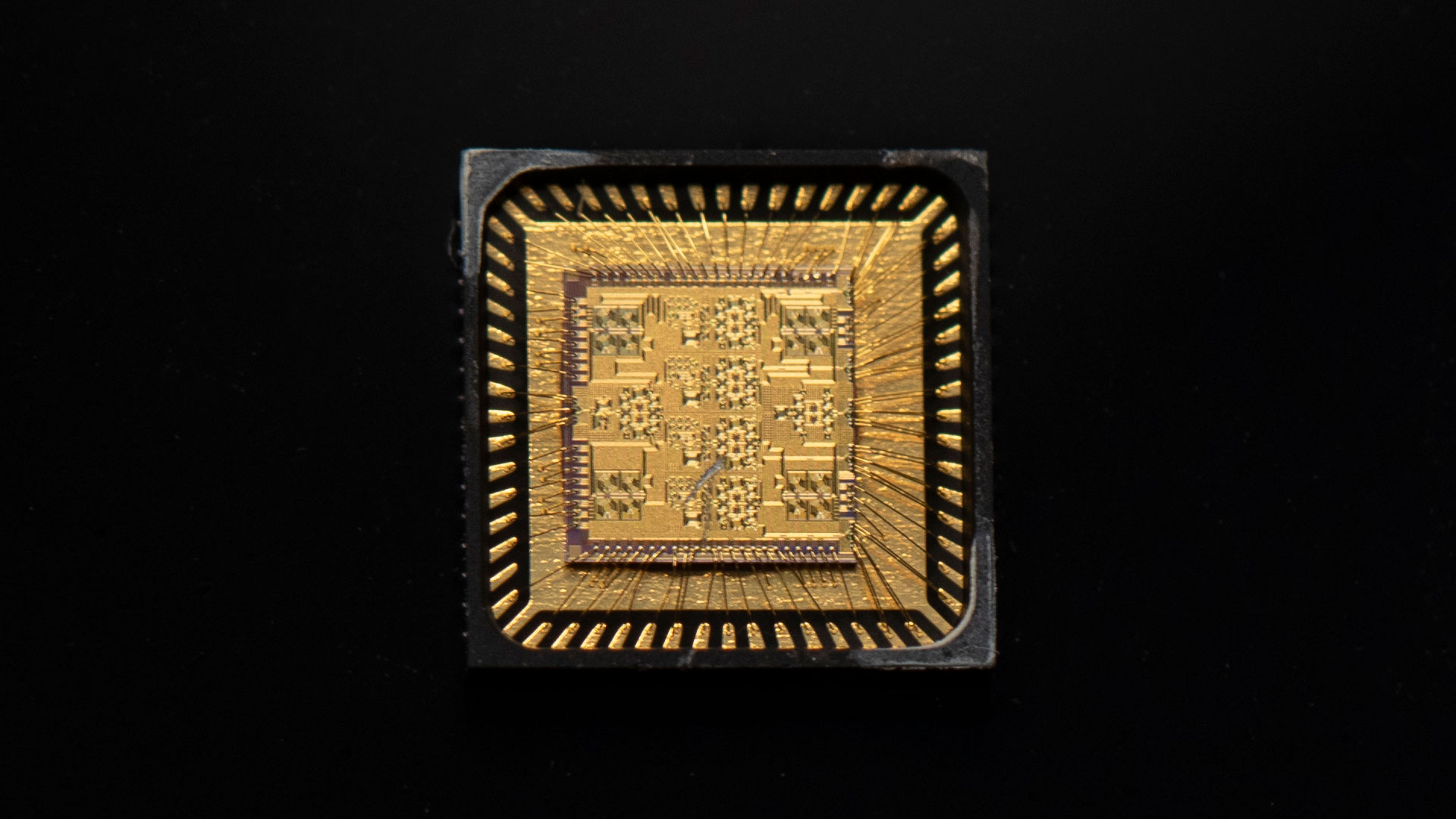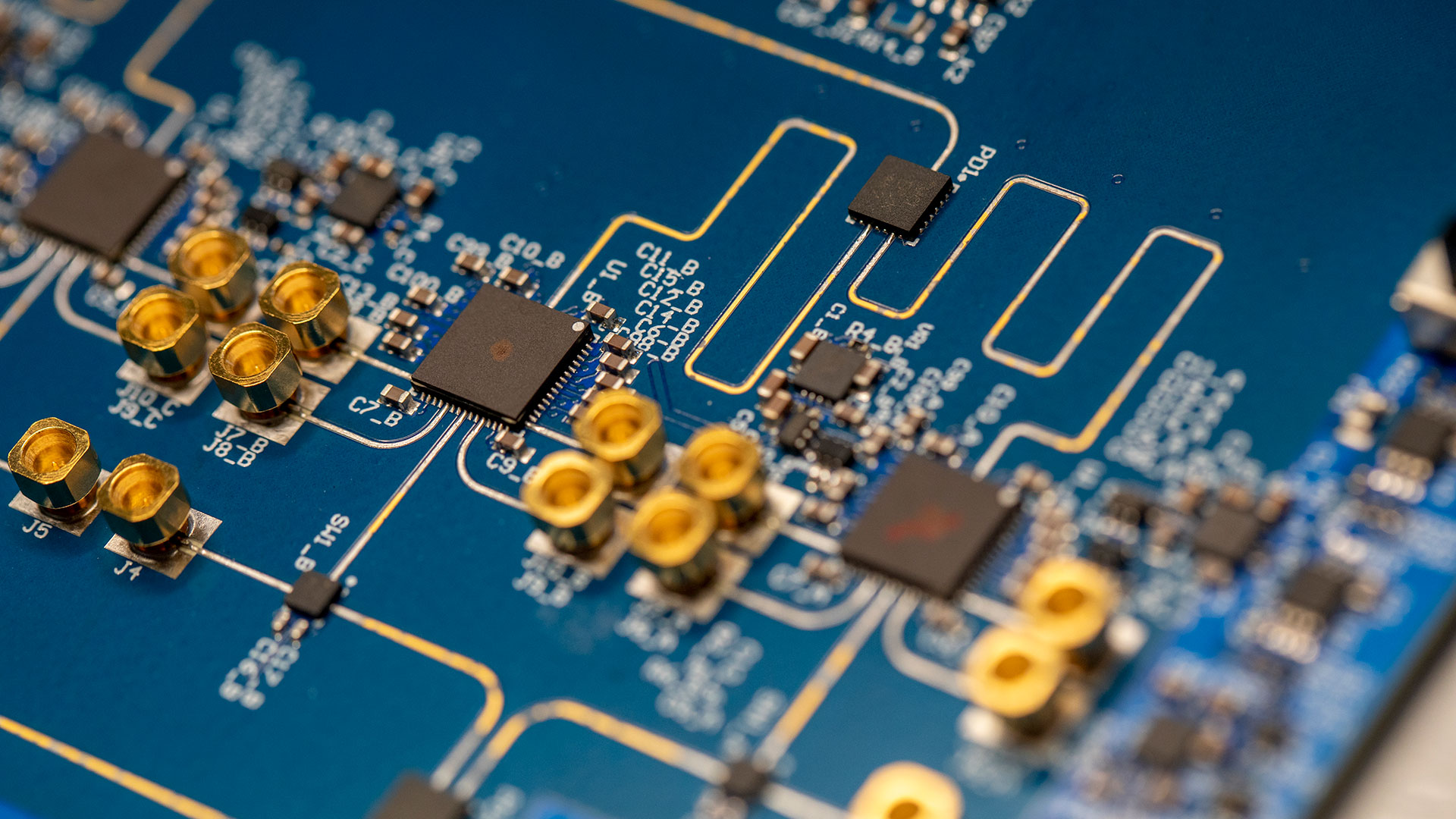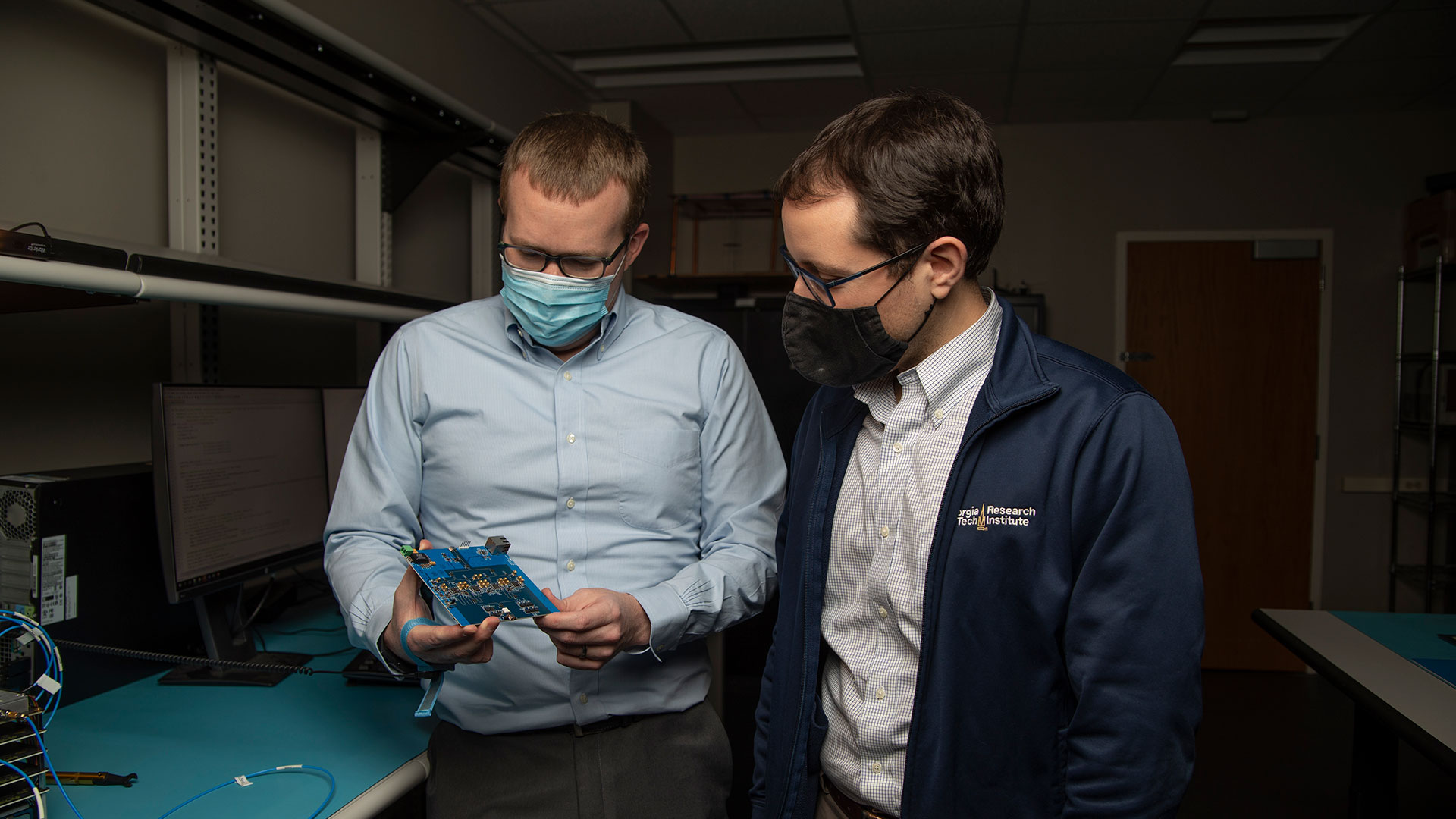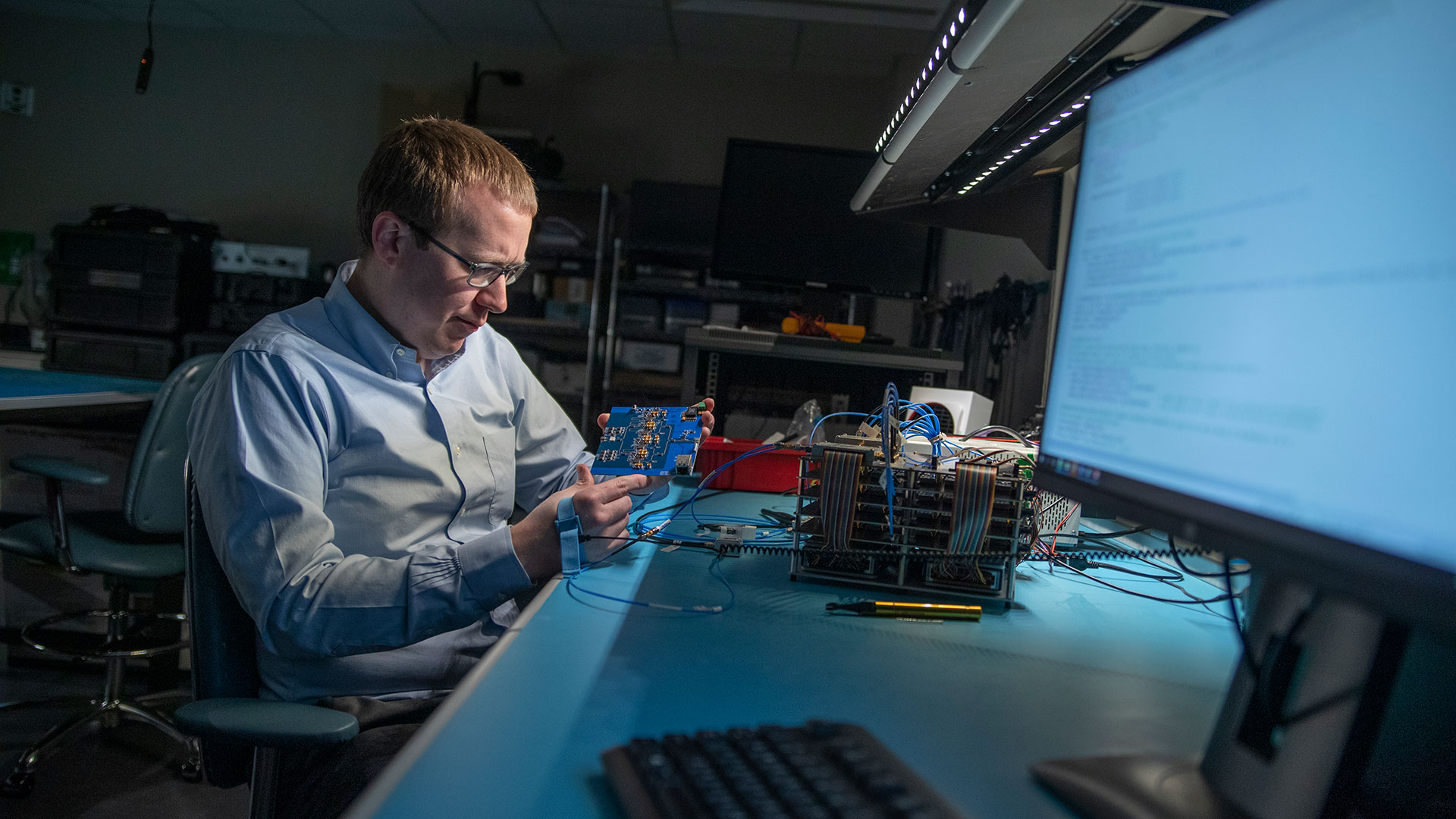Researchers have developed a new general-purpose, high-performance monolithic microwave integrated circuit (MMIC) for the direct filtering and processing of radio frequency (RF) signals in the microwave and millimeter-wave spectrum. The IC is designed to meet the need for high-frequency, wideband analog electronics for specialized applications with small form factors and challenging weight and power budgets.
The device, known as Transversal Radio Frequency Filter Integrated Circuit (TRAFFIC), has demonstrated a fully-reconfigurable 10-to-1 analog finite impulse response (FIR) filter for tunable filtering across a wide band of frequencies from 2 to 20 gigahertz. TRAFFIC was implemented in silicon-germanium (SiGe) technology, a platform designed for high-frequency performance of mixed-signal and analog IC designs.
VIDEO: New integrated circuit enables direct processing RF signals.

TRAFFIC is designed to reduce size, weight, power and cost requirements while lowering system latency. (Credit: Sean McNeil, GTRI)
Reducing Size, Weight and Power Needs
TRAFFIC is intended to reduce the size, weight and power (SWaP) requirements of RF front-ends while providing broadband, instantaneous reconfigurability and multi-function RF capability. The GTRI team has already demonstrated TRAFFIC as a front-end reconfigurable filter and new efforts are on-going to leverage this technology as an analog signal conditioner within a self-interference cancelling system.
“TRAFFIC is really about putting more of the functionality closer to the aperture,” said Doug Denison, director of the Advanced Concepts Laboratory at the Georgia Tech Research Institute (GTRI). “Doing that potentially reduces size, weight, power and also cost, while lowering latency through the system and relieving some of the burden on digital components.”
Filtering out unwanted high-power or out-of-band signals before they enter digital signal processing can improve a system’s ability to process low-power signals of interest by preserving the dynamic range of the incoming signal. The FIR filtering also allows pre-compensation for distortion that occurs when amplifiers operate in saturation – a condition that can make them more power efficient.
TRAFFIC was designed to be highly reconfigurable, allowing it to provide the flexibility that in the past has been delivered by power-hungry digital blocks that were needed to convert analog signals to digital for processing, explained Nelson Lourenco, a GTRI senior research engineer who is the program’s project director.
“High-speed digitization blocks targeting microwave frequencies are expensive and consume a lot of power,” said Lourenco. “In RF, we can perform processing similar to what can be done in field programmable gate arrays (FPGA), with the idea being that since this is a small integrated circuit, we can put it very close to antennas and integrate it by developing form factor solutions that are very small.”

TRAFFIC, a new integrated circuit design, could meet the need of high-frequency, specialized wideband analog electronics. (Credit: Sean McNeil, GTRI)
Moving Processing Closer to the Aperture
Beyond the heavy power needs, conversion of analog signals to digital introduces latency into the system, and imposes speed and bandwidth limits that require signals to be sampled instead of fully processed. TRAFFIC’s wideband capabilities allow aperture data to be directly analyzed without sampling.
“Anything we can shift from digital to analog will make the system more capable,” said Lourenco. “We can configure it more quickly, reduce latency and integrate the electronics right at the antenna. Some of the sensitive processing that we need to do can be done directly in RF, which opens up a lot more capability.”

Researchers Nelson Lourenco and Chris Coen with the TRAFFIC integrated circuit in a GTRI electronics testing laboratory. (Credit: Christopher Moore, GTRI)
Using the Benefits of Silicon Germanium
The GTRI researchers worked with John Cressler, a Regents Professor in the Georgia Tech School of Electrical and Computer Engineering, to develop the TRAFFIC architecture in silicon-germanium (SiGe), a semiconductor material used for heterojunction bipolar devices designed to provide high-frequency performance in mixed-signal circuit and analog circuit ICs.
Cressler’s team brought a number of novel circuit designs to the project, and demonstrated that the fully integrated filter IC could meet the demanding performance specifications. The IC was based on a 250 GHz, 130 nm SiGe BiCMOS (bipolar + CMOS) platform from semiconductor manufacturing and design company GlobalFoundries.
“SiGe technology is a commercially-available, low-cost, high-performance, fully silicon compatible IC technology that is ideal for realizing performance constrained ICs such as this active filter,” Cressler said. “The SiGe technology is able to meet the demands of the highly integrated, compact active filter that is the showpiece of TRAFFIC’s FIR processor.”
To support system-level demonstrations, GTRI researchers also developed testbeds for integrating multiple TRAFFIC blocks and showcase its modular nature. Georgia Tech is seeking patent protection for the IC architecture, and presented details of the work December 5-8 at the 2021 IEEE BiCMOS and Compound Semiconductor Integrated Circuits and Technology Symposium.

Researcher Chris Coen examines the TRAFFIC integrated circuit in a GTRI electronics testing laboratory. (Credit: Christopher Moore, GTRI)
Flexibility to Support Niche Applications
Though implemented first in SiGe, TRAFFIC could be fabricated in gallium arsenide, gallium nitride, indium phosphide or other platforms. “There are certain niche applications where silicon isn’t going to be the best, and TRAFFIC will support those by being technology agnostic,” Lourenco said.
The programmability of TRAFFIC creates a strong advantage in the kinds of applications GTRI develops for its sponsors, Denison said.
“As the signal environment changes, we can dynamically adapt to that environment with our analog hardware at the front of the system,” he said. “Our filters are entirely programmable so we can dynamically tune its performance, essentially over microsecond time scales.”
Development of the TRAFFIC application has helped give GTRI a new capability for in-house circuit design, which is important for meeting the requirements of the specialized applications it develops.
“To get the bandwidth and the kind of size, weight and performance that we require, we need to have an IC design capability,” Denison said. “Our interest in this was for high-frequency, wideband analog electronics.”
In addition to those already mentioned, the research team also included Chris Coen, Nancy Saldanha, John Morse, Chris Howard, Billbang Sayasean, Jeramy Marsh, Matthew Tate, Javier Sarabia, Phillip Moore, Peter McMenamin, Paul Jo, Craig Swanson, Michael Grady, and Bill Hunter, all from GTRI. Adilson Cardoso, formerly from GTRI, was also a key contributor to the TRAFFIC program.
Writer: John Toon
GTRI Communications
Georgia Tech Research Institute
Atlanta, Georgia USA
![]()
RETURN TO 2021 ANNUAL REPORT HOME
The Georgia Tech Research Institute (GTRI) is the nonprofit, applied research division of the Georgia Institute of Technology (Georgia Tech). Founded in 1934 as the Engineering Experiment Station, GTRI has grown to more than 2,800 employees supporting eight laboratories in over 20 locations around the country and performing more than $700 million of problem-solving research annually for government and industry. GTRI's renowned researchers combine science, engineering, economics, policy, and technical expertise to solve complex problems for the U.S. federal government, state, and industry.



